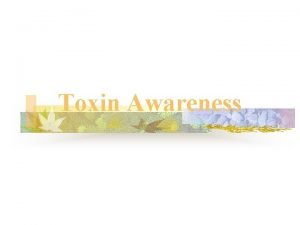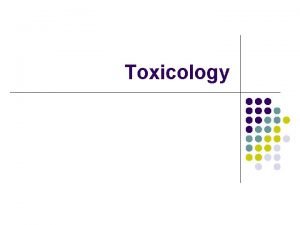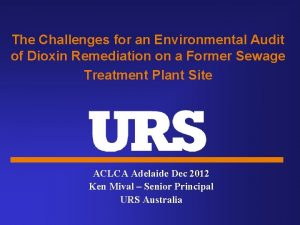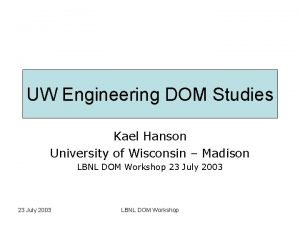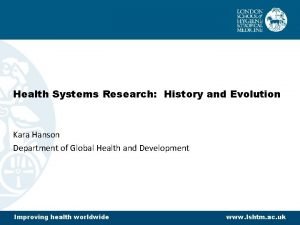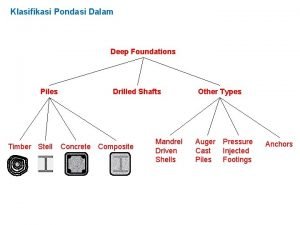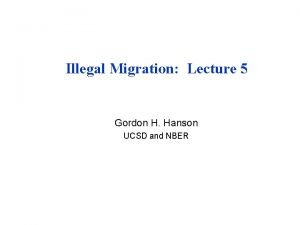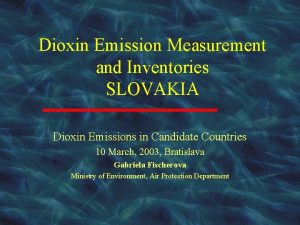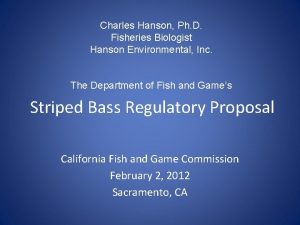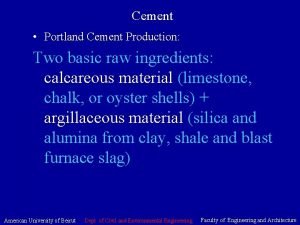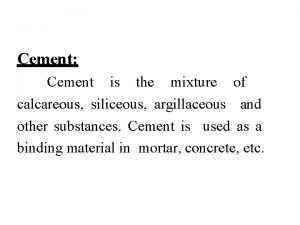Hanson Cement Review of Dioxin data Professor David































- Slides: 31

Hanson Cement: Review of Dioxin data Professor David Russell Centre for Radiation, Chemicals and Environmental Hazards (Wales) The Health Protection Agency Cardiff Wales UK

Principal areas • Physico-chemical properties • Sources • Routes of exposure • Potential health effects • Findings • Conclusions

Dioxins: Physico-chemical properties • Generic term for group of 210 chemicals of similar structure. • 2 principal groups, dibenzo-furans and chlorinated dibenzo-dioxins • CDDs -75 compounds • Differ in amount of chlorine atoms present. • Most pose no threat to health at levels found in environment. • 17 are of concern • TCDD most toxic.

Physico-chemical properties (continued) • High molecular weight, solid or crystals • Low vapour pressure • Non-flammable • Odourless • Fat soluble • Environmentally and biologically stable

Sources • No commercial production • Man-made (anthropogenic) and natural sources. • Combustion and incineration processes-smelting, paper bleaching, vehicle emissions. • Cigarette smoke • Natural sources include forest fires. • Levels in the environment have declined since 1970 s.

Environmental fete and exposure • Persistent and ubiquitous • Air-molecules, particles, ash • Soil (avid binding) • Water (sediment) • Plant leaves • Exposure largely ingestion (food). • 90% through consumption of meat, dairy products and fish.

Potential health effects • Acute exposure-commonest effect is chloracne • High dose exposure-nausea, vomiting, diarrhoea and weight loss. • Neurological symptomsheadaches, generalised weakness and muscular pains. • Similar effects whether through inhalational, oral or dermal exposure.

Potential health effects-chronic • Similar to severe acute exposure. • Based on accidents, occupational and residential exposure, as well as animal studies. ØChloracne ØLiver disease ØCardio-vascular disease ØAlterations in immune and thyroid function ØCause cancer in laboratory animals. Non-genotoxic

Dioxins and Cancer • Dioxins are non-genotoxic carcinogens ie they do not directly bind to genetic material (DNA). • They display threshold characteristics. • Below the threshold, no observable adverse effect. • NOAEL-highest dose at which there is no significant increase in biological effect or frequency of effect. • LOAEL-lowest dose at which an adverse effect seen. • Based on most sensitive effect in most sensitive species. NOAEL

Regulatory Toxicology NOAEL • Based on the most sensitive health end point in the most sensitive species. • Used to define a tolerable daily intake for humans following introduction of an uncertainty factor (UF). • Typically UF is two-fold involving a consideration for both inter-and intra -species variability. • Usually of order of 100 • TDI=NOAEL/Uncertainty factor • Therefore TDI incorporates large safety factor and is conservative

Dioxins: LOAEL Approach • Female rats basis of TDI • LOAEL used to reflect body burden • Extrapolation to humans using safety factor • TDI of 2 pg/kg/day [note: 1 pg = 10 -12 g]

UK National Emissions • Significant reduction over 20 years. • Reflects more stringent regulation. • By 2008, most emissions from urban sites.

UK Emissions Total UK dioxin emissions to atmosphere 1990 -2009 (Source: NAEI)

National dioxin emissions: Manufacturing and construction sector Total UK dioxin emissions to atmosphere from combustion in manufacturing and construction sector (source: NAEI)

Regional emissions 2008 • Hanson Cement largest point source emitter in Flintshire. TT • 6 th. largest in Wales. • Contributed 1% of total emissions from “top ten” emitters in Wales. • 11% of dioxin emissions from all point sources within 15 mile radius. Total modelled emissions of dioxins on 1 km grid basis (NAEI; 2008)

Regional Point Source Emissions

Dioxin emissions from Hanson Cement • General trend of decreasing emissions. • Mirrors national trends • Notable exception of 2004. • Extrapolation of stack emissions to human exposure requires intake estimation based upon soil, herbage and dairy product concentrations and consumption. • Can then compare with TDI. Total emissions of dioxin to environment from cement works at Padeswood

Exposure to dioxins Deposition SOURCE Inhalation Ingestion Production Ingestion

Dioxins in food • Dioxins are found at low levels in all foods, including foods that are important sources of nutrients • Mainly fatty foods such as meat, fish and dairy products • Intakes are falling and have reduced by 85% since 1982

Regulatory limits • Introduced in 2001 by the EC • Formally reviewed in 2006 based on the results of monitoring and new research • Constantly under review in working groups • It is important to understand that regulatory limits are not safety limits • Consuming a portion of food that does exceed a limit does not necessarily imply a risk to health

Regulatory limits • Contained within regulation (EC) 1881/2006 (as amended) • Using milk as an example; • Dioxins = 3. 0 picogram(pg)/g fat • UK also operates action levels whereby investigations are conducted into the source of the contamination • Action level for milk is 2. 0 pg/g fat

Tolerable Daily Intake (TDI) • TDI as a means to assess risk from dioxins • 2001 assessment by the Committee on Toxicity (COT) - 2 pg/kg bw per day • 2007 reaffirmation by COT • WHO 1 – 4 pg/kg bw per day

FSA surveys • Dietary exposure to dioxins in a variety of foods purchased at retail throughout the UK was studied in 2007 • No samples exceeded existing regulatory limits. There were no concerns for human health. • Have also conducted targeted surveys at offal, infant formulae, fish, shellfish and fish oil supplements • Current exposure estimated to be 1. 4 pg WHO-TEQ/kg bw/day.

Local results • Sample results available between 2004 and 2009 – milk, soil and vegetation (moss) • 2004 samples taken from a variety of locations around the plant • 2005 – 2009 from Dyke farm • Samples taken by company and provided to EA • Cannot distinguish between sources of dioxins

Milk 3. 50 Milk samples taken from Dyke farm 3. 00 pg/g fat 2. 50 Regulatory limit 2. 00 Action level Farm sample 1. 50 UK retail milk 1. 00 0. 50 0. 00 2005 2006 2007 2008 2009

Milk • No results above regulatory limit or UK action level • UK retail milk (2006) – 0. 34 pg/g fat (+/-0. 09) • Highest result from Dyke farm (2006) – 1. 85 pg/g fat • Last result from Dyke farm (2009) – 0. 70 pg/g fat • Consumption of milk at the highest level (every day) would not result in an adult breaching the TDI even when combined with exposure from the rest of the diet 1 pg/g = 1 ng/kg = 1 g in 1, 000 tonnes

Soil • Highest result (2005) – 19 ng/kg • Last result (2006) – between 0. 2 and 17 ng/kg • 2008 residential sample – 22 ng/kg • Welsh rural soils between 0. 28 and 27. 77 ng/kg (n=33)* • Median result from survey was 1. 83 ng/kg • Comparable with UK results • Uptake of dioxins into plants via their roots is generally negligible • Washing and peeling removes the vast majority of surface contamination from the soil * - Environment Agency soil and herbage study

Soil • Standard advice issued by the Agency to all consumers of allotment produce is: • to thoroughly wash your hands after gathering • to thoroughly wash and peel all produce prior to consumption • to consume products from different sources and not to source all of your produce from the same plot

Vegetation • Highest result (2006) - 0. 10 -0. 11 ng/kg • Last result (2009) – 0. 02– 0. 03 ng/kg • The levels of dioxins appear to be very low; however, as no control data are available it is not possible to extrapolate from these samples to uptake of contaminants into vegetation.

Conclusions • Dioxins are the product of man-made and natural sources • They are by-products and have no commercial use • Dioxins are ubiquitous • National (UK) emissions of dioxins have reduced significantly over 20 years. • Emissions from Hanson Cement have fallen markedly since 2000, reflecting new kiln. • Hanson Cement largest point source emitter of dioxins in Flintshire. • Contributes 11% of point source emissions within 15 mile radius. • Greatest source of exposure likely to be through food chain

Conclusions • Dioxins are present in all foods • Intakes are falling and have reduced by 85% since 1982 • Current exposure estimated to be 1. 4 pg/kg bw per day • TDI is a key indicator for determining the risk of health impacts – 2 pg/kg bw day • Milk and soil sample results show no concerns for health • Standard advice
 Dioxin poisoning
Dioxin poisoning Dioxin poisoning
Dioxin poisoning Dioxin poisoning
Dioxin poisoning Promotion from assistant to associate professor
Promotion from assistant to associate professor Lori hanson dnr
Lori hanson dnr Sijan
Sijan Hyperrealismus
Hyperrealismus De stijl schroder house
De stijl schroder house Gbs re rpa
Gbs re rpa Bc2k
Bc2k Kael hanson
Kael hanson Hanson center for technical communication
Hanson center for technical communication Kara hanson
Kara hanson Cedis centre de distribution
Cedis centre de distribution James hanson will and grace
James hanson will and grace Capacitor antony gormley
Capacitor antony gormley Peck hanson and thornburn 1974
Peck hanson and thornburn 1974 Duane hanson
Duane hanson Duane hanson
Duane hanson Hanson wok
Hanson wok Duane hanson supermarket lady
Duane hanson supermarket lady Linda, chuck close
Linda, chuck close Magdalena frida kahlo
Magdalena frida kahlo Hanson 2002
Hanson 2002 Les hanson
Les hanson North springs magnet program
North springs magnet program Gordon h hanson
Gordon h hanson Gil hanson
Gil hanson Hanson stadium chicago
Hanson stadium chicago Professor david nicol
Professor david nicol David clutterbuck partnership
David clutterbuck partnership David best recovery
David best recovery
